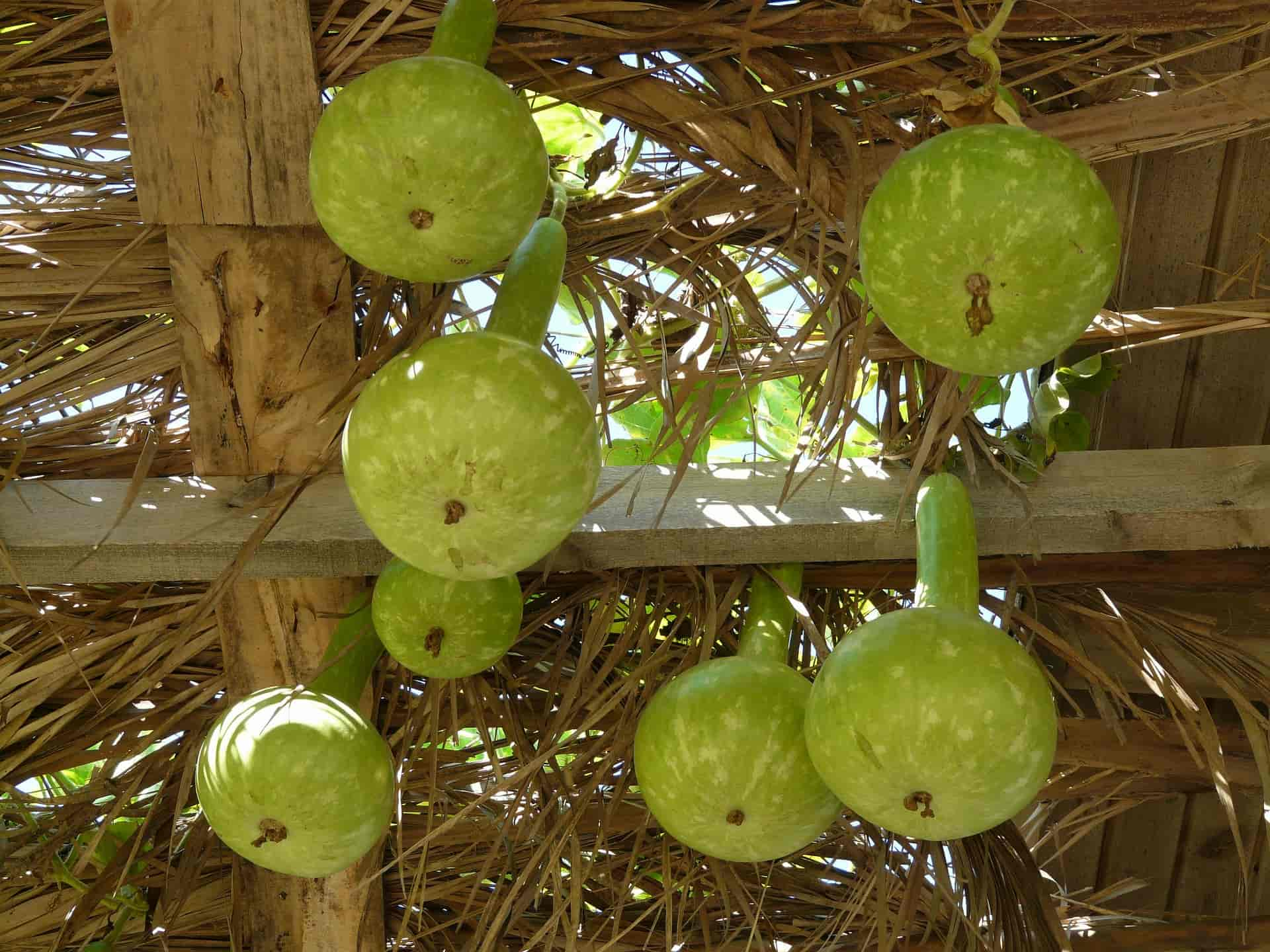
Gourd or calabash: sowing, cultivation and harvest
Contents
Gourd in a nutshell
- Annual vegetable plant from the gourd family, the calabash (Lagenaria siceraria) is also known as gourd
- The calabash is a particularly vigorous climbing or trailing plant, with stems that can reach up to 10 metres long
- It produces white flowers followed by fruits of varying sizes and sometimes surprising shapes
- Gourds are edible when young but become bitter at ripeness
- With rare resilience, calabashes have a decorative aspect and can be used to make utensils or musical instruments
A word from our expert
The reasons for growing the bottle gourd (Lagenaria siceraria) are numerous. Indeed, this astonishing and unusual annual vegetable plant, native to Africa, has several advantages that may appeal to the curious gardener. Firstly, this climbing plant has exceptional vigour, allowing it to cover a pergola, trellis, or fence very quickly. Its stems can reach lengths of up to 10 metres.
The bottle gourd can also be grown for its somewhat unusual flowers within the large family of cucurbits. Unlike its relatives, the bottle gourd produces white, twilight-flowering blooms. Then, bizarrely shaped fruits emerge. These fruits have a smooth and verrucate epidermis, with great hardness that allows for the creation of various everyday objects or musical instruments. Edible two months after sowing, these fruits are marked by a strong bitterness at ripeness due to their high cucurbitacin content.
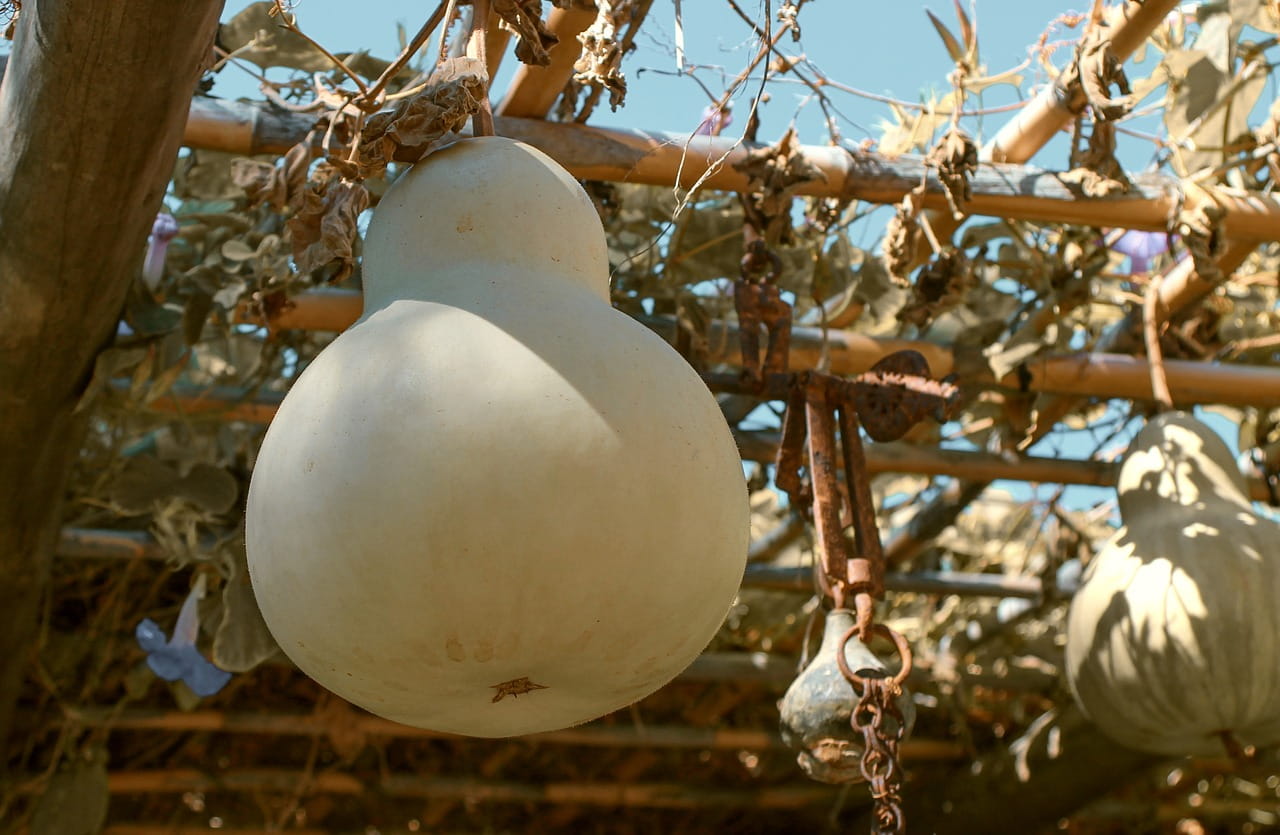
The bottle gourd is an ideal herbaceous plant for dressing a pergola
The bottle gourd requires sunlight and fresh, organic-rich soil. In fact, growing it with its roots in compost suits it perfectly.
Botanical description
The gourd is one of the oldest domesticated plants. It is believed to be native to sub-Saharan Africa. However, as a great traveller, its traces can be found in both America and Asia. Indeed, the gourd may have been carried by the waves to the shores of the New World. Once its flesh retracts, housing the seeds, it has the ability to float. Other historians suggest it could have been transported by prehistoric humans during their migrations. The oldest traces of Lagenaria siceraria have been discovered in Peru, dating back to 13,000-8,000 BC.
Nonetheless, Lagenaria siceraria is mentioned in the writings of Pliny the Elder (23-79) and in the Capitular of Villis, written in the Middle Ages under Charlemagne, which lists all the plants that are useful to cultivate in a fortified castle.
Etymologically, Lagenaria siceraria comes from the Latin lagoena, meaning bottle or flask, and from the Latin sicaeraria, meaning dry.
The gourd is an annual herbaceous plant belonging to the family Cucurbitaceae. It is of the genus Lagenaria, which includes five other wild African species, all marked by their bitter fruits. Lagenaria siceraria is the only cultivated species, which has numerous local varieties that vary in shape and size. It is also known as the White-flowered Gourd.
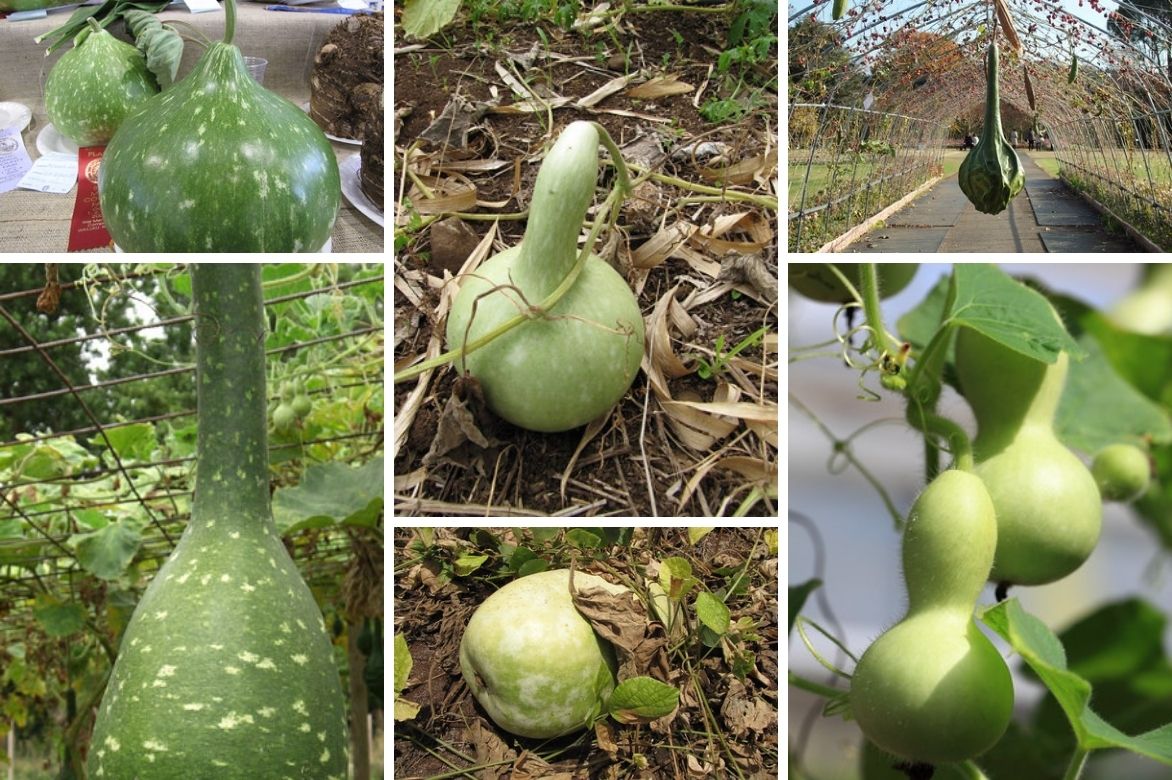
Gourds vary in shape and size
It is a monoecious herbaceous plant equipped with tendrils that allow it to climb or sprawl very easily. Particularly vigorous, it can be used to cover a pergola or sturdy fencing, or to hide a mound of earth. If it has optimal growing conditions, the stems of the gourd can reach up to 10 metres long for some varieties.
Its alternate leaves are heart-shaped, slightly lobed, and undulate. They measure 15 to 25 cm in diameter and are villous and rough. When crushed, they can emit an unpleasant odour.
Its flowers are unisexual, solitary, and located in the axil of the leaves. They can reach 15 cm in diameter. They have five petals, fused at the base, forming a star. Unlike other cucurbits, the flowers open at dusk and close 8 to 20 hours later. The gourd flowers in spring. Male flowers arise on longer pedicels than female flowers, which are distinguished by a swelling corresponding to the ovary, densely hairy. As they wither, the flowers take on the appearance of original white lace.
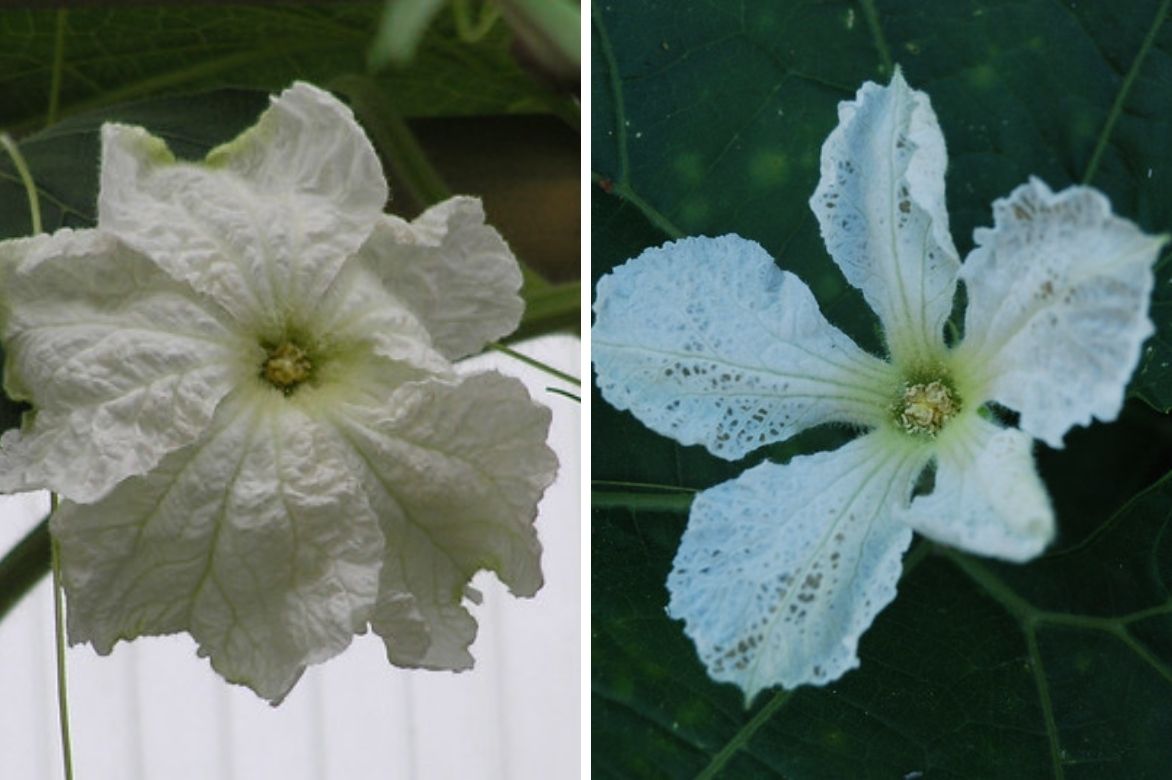
Over time, the flowers become lace-like
Following the flowers, fruits appear that vary greatly in size and shape, often resembling a bottle or a club. Some can measure up to 1 metre long. Their colour ranges from yellow-white to dark green, turning brown once the gourd is ripe and dry. Some varieties may be speckled with white. All have a hard, tough, thick skin, smooth or covered with warts, which conceals a soft, white flesh that retracts. The seeds are oblong, marginate at the base, rather flat and smooth, and about 2 cm long. Depending on local customs, these fruits can be consumed when immature. When mature, they become very bitter. However, it is primarily once the shell is dry that the gourd is used for a multitude of purposes. In Africa, it is widely used as a container for transporting or storing drinking water, beer, milk, honey, salt, animal fat, seeds… They are also used as vases, feeders, pots, masks or puppets, decorative objects of all kinds, especially since they can be easily painted or screen-printed.
Gourds are also widely used in the making of musical instruments. They serve as resonating boxes for the kora, balafon, berimbau, certain drums, maracas…
Read also
Powdery mildew or white diseaseThe different varieties of gourds
There are numerous varieties of gourds distinguished by their shape. Some are round, others have a more or less swollen neck, and some take on a club-like shape. This includes the club gourd, the pilgrim gourd, the siphon gourd, the amphora gourd, the powder pear gourd, and the flat gourd from Corsica. The club gourd can reach extraordinary sizes, with fruits measuring from 60 cm to 2 metres, and a diameter of 10 to 12 cm. The siphon gourd, also known as the bottle gourd, produces club-shaped gourds of 90 cm with a very long neck. The Swan Neck has dark green fruits speckled with white, resembling the neck of birds as it grows along the ground. The Flat gourd from Corsica produces light green, round, flat fruits measuring 15 cm in diameter.
Our favourites
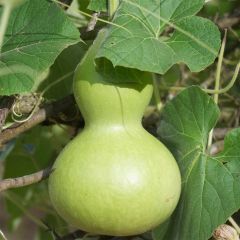
Lagenaria siceraria Pélerine
- Blütezeit August, September
- Höhe bei Reife 1,20 m
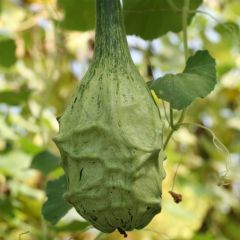
Lagenaria siceraria 'Marenka'
- Blütezeit August, September
- Höhe bei Reife 45 cm
Planting gourds
What soil and exposure for the gourd?
Gourds thrive in sunlight. They can tolerate a spot in partial shade, but fruiting may be less abundant. Due to their very rapid growth, gourds are perfect for climbing up a wall, dressing up a pergola, or covering an unsightly (but sturdy!) fence. Do keep in mind the size of the fruits at ripeness. Some can reach 50 to 60 cm in length and may be cumbersome if you need to dine under your pergola! Round gourds, flat with a curved neck, can also find their place on a mound. Finally, planting in a pot on a balcony or terrace is possible, provided the space is large enough.
As for the soil, it must be rich. Very rich indeed, which is why a good supply of manure is recommended. It is also not uncommon to see gourds growing directly in a compost heap where they find all the nutrients they need. The nature of the soil is not crucial. However, it must remain cool and be perfectly drained and loose. Adding mulch is also advisable to maintain some moisture.
When to sow the gourd?
Gourd seeds are sown in spring, in March or April depending on the regions, and generally, three weeks before transplanting outdoors. Sow in pots filled with a substrate rich in organic matter, keeping them under glass or in a warm place at a temperature of 20 °C. Only place one seed per pot, burying it 4 to 5 cm deep. The substrate should be moist.
The germination is very rapid, taking about ten days. Once the risk of frost has passed, the seedlings are transplanted outdoors. If the seedlings linger in the pots, they become fibrous. Moreover, their recovery will be compromised, and their growth slowed.
Planting in the ground
- Loosen the soil with a rake
- Dig holes about 30 cm in diameter and 30 cm deep, spaced one metre apart
- Fill with compost
- Place the gourd plants in the ground and bring the soil around the base
- Water.
For pot planting, choose a high-quality potting mix rich in nutrients.
Read also
Squashes: buyer's guideCaring for the water bottle
Gourds need to have cool soil. Watering should therefore be generous, preferably in the late afternoon, avoiding the hottest parts of the day. Of course, it is important not to wet the foliage to prevent the development of fungal diseases. Mulching is recommended as it retains some moisture, which is appreciated by gourds.
Be sure to regularly weed the area around the base of the gourd to ensure good air circulation for the foliage. Weeding should be done by hand, as it is not advisable to turn the soil too systematically during the fruiting period. Indeed, the root system of the gourd is quite shallow.
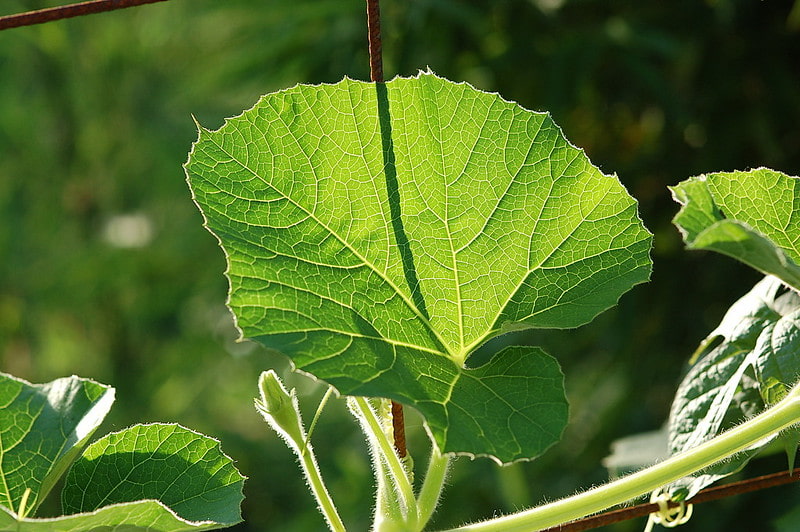
Gourds often need to be staked
It is essential to help the stems cling as they develop. Pruning is completely unnecessary.
Several diseases can affect the gourd, particularly powdery mildew, downy mildew, and anthracnose. To prevent these diseases, it is crucial to avoid wetting the foliage during watering and to remove all affected leaves. A spray of horsetail decoction can help prevent powdery mildew and anthracnose. Bordeaux mixture is effective against downy mildew.
When to harvest gourds?
If you wish to eat your gourds like courgettes, harvest them before the fruits are fully ripe, around June, two months after sowing. The fruits are indeed edible when they are young, tender, and still green.
If you want to use your gourds as decorative objects, harvest them 5 to 6 months after sowing, in August or September. To know if it’s the right time, observe the peduncle, which should be dry. Additionally, the foliage will also have dried, and the fruits will be ready to detach themselves. The fruit will also have taken on its final colours.
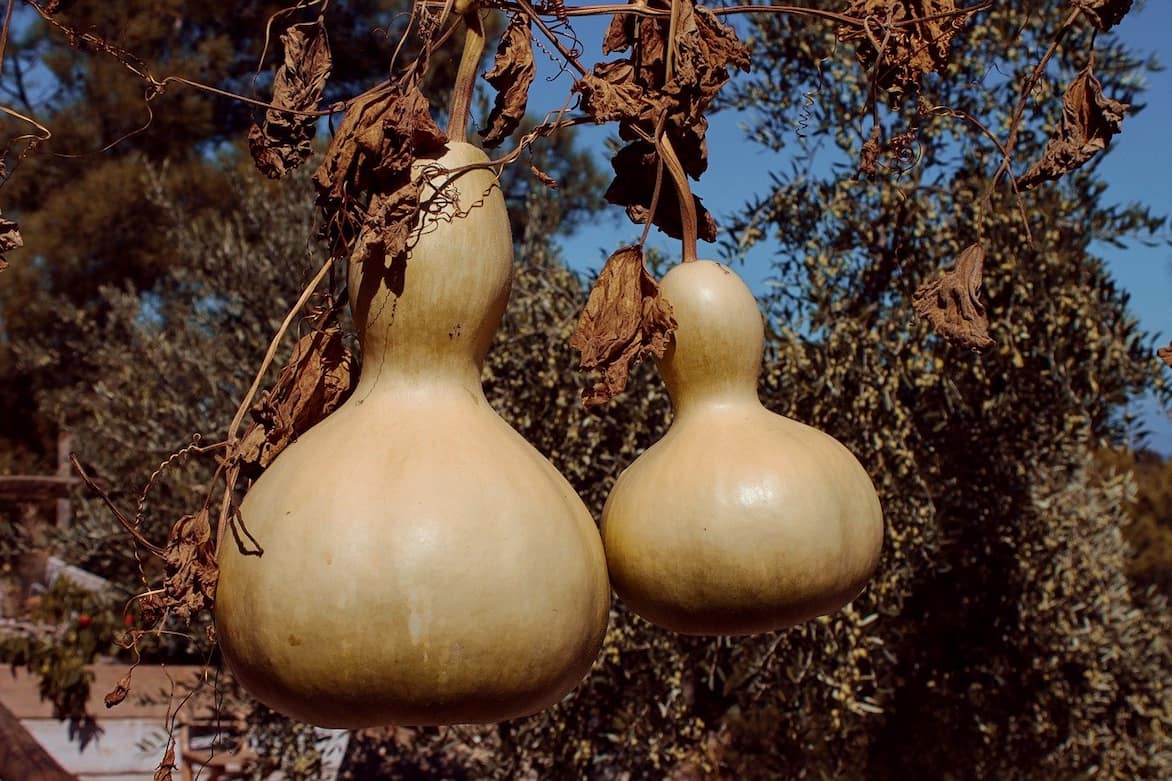
Gourds are harvested when the peduncle and foliage are dry
If you want to use your gourds as containers, it is very important to leave them on the plant until they are fully mature. After harvesting, soak the fruits in water, then remove the pulp and seeds with a stick. All that’s left is to clean the bark with Marseille soap and dry it carefully. Polishing with beeswax adds shine to the epidermis.
If autumn is humid, which compromises the ripening of the gourds, it is possible to pick them. They will finish drying indoors.
Don’t forget to save the seeds.
The various uses of the gourd
Once dried, the gourd can be painted, carved, chiselled, polished, varnished… It can be transformed into beautiful decorative objects such as a pierced light fixture, a lantern, a pendant, or a lampshade. Alternatively, it can be made into small hanging baskets, bird feeders, or plant pots. It can also serve as a container: in Japan, gourds are traditionally used for sake, in Latin America for mate, and in Africa for craft beers or drinking water. In Africa, the use of gourds is deeply rooted in the cultures of various countries across the continent.
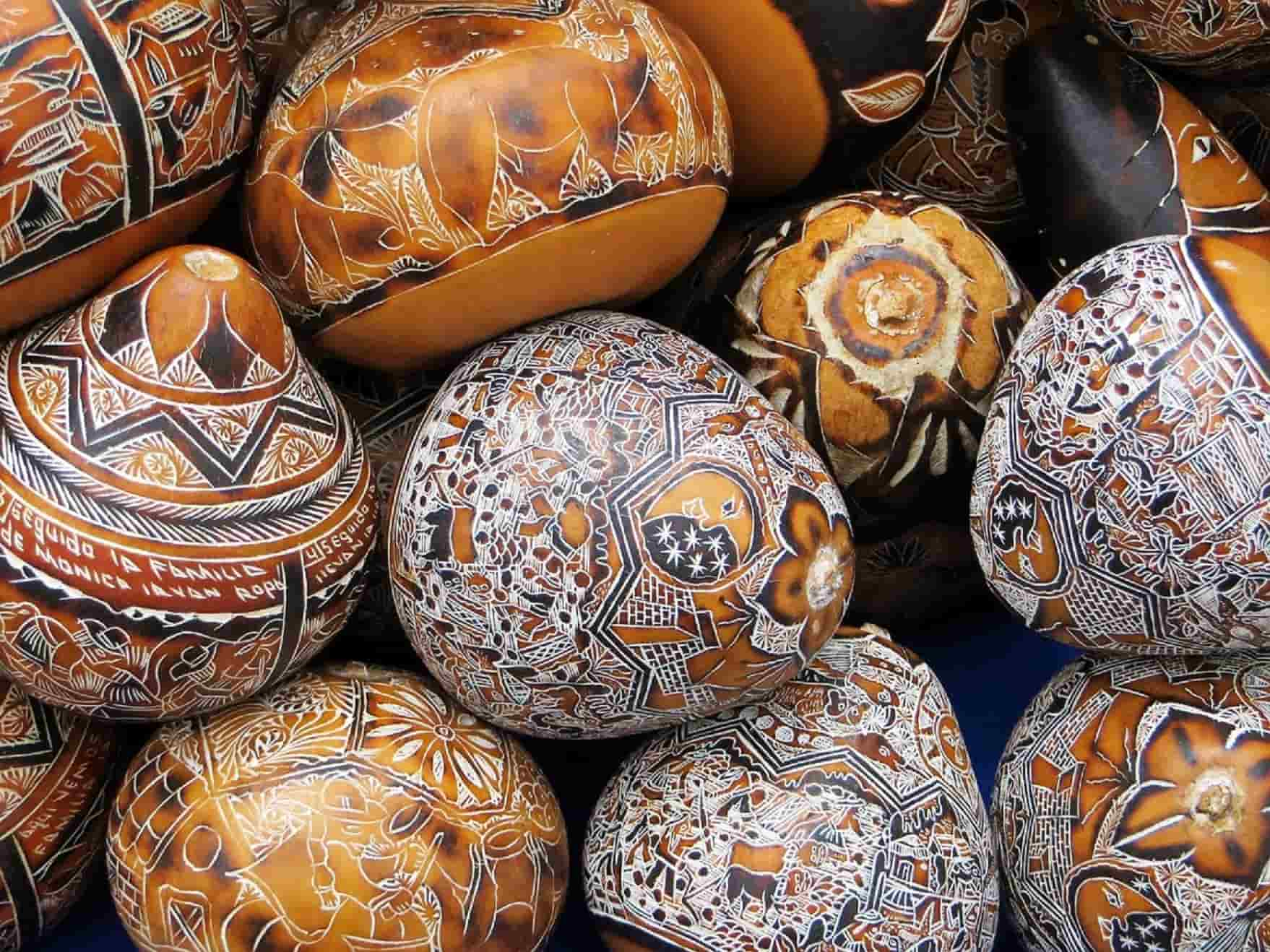 Gourds can be varnished, sculpted, painted, carved…
Gourds can be varnished, sculpted, painted, carved…
Many musical instruments are made from gourds, such as the kora, balafon, some xylophones, kalimba, water drum, djabara… not to mention maracas.
- Subscribe!
- Contents































Comments